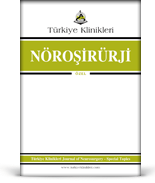Editörlüğünü üstlendiğim bu kitapta; spontane subaraknoid kanama ve anevrizmalar ele alınmıştır. Subaraknoid kanamaya sahip hastaların takip ve tedavisi büyük bir titizlik istemektedir. Cerrahi mikroskobun nöroşirürji pratiğine girmesine, hastalığın tedavi yönetiminde deneyimlerimizin artmasına ve nöroanestezideki gelişmelere rağmen, subaraknoid kanama yönetimi ve anevrizma tedavisi hâlâ ciddiyetini korumaktadır.
Subaraknoid kanama yanında birçok komplikasyonu da beraberinde getiren bir durumdur. Hipotalamik yaralanma, elektrolit dengesizliği, hematomun varlığı, sisterinlerdeki kanama miktarı ve serebral vazospazm ile mücadele etmek zorundayız. Literatürü takip etmek yanında kendi deneyimlerimizin de büyük değeri olduğunu düşünüyorum. Bu konuda çalışacak genç meslektaşlarımın subaraknoid kanama ve anevrizma cerrahi tedavisinin zaman bağımlı olduğunu ve her hastanın farklı cevap verebildiğini akılda tutmaları gerekmektedir.
Son elli yılda anevrizmaların görüntülenmesinde ve cerrahi mikroskoplarda çok büyük gelişmeler olmuştur. Üç boyutlu serebral bilgisayarlı tomografi-anjiografi (3B- BTA) ve üç boyutlu serebral dijital anjiografi (3B-DSA) anevrizmanın şekli, fundusun projeksiyon yönü hakkında doğru bilgiler verebilmektedir. Buna ilave olarak gelişmiş cerrahi mikroskobun kullanılmasının, cerrahi başarıyı artırdığı kesindir.
Özellikle 2000'li yıllardan itibaren cerrahi yaklaşıma bir alternatif olarak gelişen anevrizmaların endovasküler yaklaşımla tedavi edilmesi, ilk başta anevrizma cerrahisi son mu buluyor endişesine neden olmuştur. Başlangıçta ISAT çalışmaları temel alındığında endovasküler yaklaşımla tedavi edilen hasta sayısının mikrocerrahi ile tedavi edilen hastalardan daha fazla ve endovasküler tedavinin mikrocerrahiden daha üstün olduğu savunulmuştur. Ancak son değerlendirmelerde endovasküler yaklaşımla tedavi edilen hasta sayısının belli bir yoğunluğuna ulaşmış olması sebebiyle her iki tedavi yaklaşımına daha iyi bir değerlendirme imkânı vermiştir. İkisi arasında mortalite ve morbidite açısından bir fark olmadığı raporlanmasına rağmen, endovasküler yaklaşım lehine hasta sayısında bir artış olduğu kesindir. Şunu açıkça söylemek gerekir: Anevrizmalara endovasküler ve mikrocerrahi yaklaşımlar birbirine rakip değil, birbirini destekleyici tedavilerdir. Burada temel prensip her biri için uygun hastanın seçimidir.
Anevrizma cerrahisi yapan her beyin cerrahının serebral revaskülarizasyon yapabilme yeteneğine sahip olması gerektiğini söylemek artık bir abartı olmaz sanırım. Anevrizma cerrahisinde her an istenmeyen bir olayla karşılaşabiliriz. Bunun yanında kompleks serebral anevrizmaların tedavisinde baypas cerrahisinin uygulanmasının gerekliliği açıktır. Özellikle genç meslektaşlarımın baypas anastomoz tekniklerini öğrenmelerini ve uygulamalarını önemsiyorum.
Sonuç olarak, nöroradyolojik, nöroanestetik ve mikrocerrahideki ilerlemelere rağmen anevrizma tedavisi hâlâ ciddiyetini ve yer yer de gizemini korumaktadır. Anevrizmanın sorunsuz kliplenmesi elzemdir ama bu, tedavide başarıyı getirmeyebilir. Gecikmiş serebral iskemide karşılaştığımız inatçı vazospazm, çözmemiz geren en önemli problemlerden biridir. Ülkemizde anevrizmaların gerek mikrocerrahi gerekse endovasküler yaklaşımla tedavisinde iyi bir yerde olduğumuzu söyleyebiliriz. Konusunda etkin ve deneyimli hocalarımıza bilgilerini ve deneyimlerini bizimle paylaştıkları için teşekkür ediyorum.
Saygılarımla.
Prof. Dr. Ramazan DURMAZ
Editör
In this book, in which I have been serving as an editor, spontaneous subarachnoid hemorrhage and aneurysms are discussed. The follow-up and treatment of the patients with subarachnoid hemorrhage require great care. Despite the introduction of the surgical microscopy into neurosurgical practices, our increased experience in managements of the treatment of the disease and the improvements in neuroanesthesia, the management of subarachnoid hemorrhages and treatment of aneurysm still remain a serious problem.
Subarachnoid hemorrhage is a condition that brings many other complications along with. We have to deal with hypothalamic injury, electrolyte imbalance, the presence of hematoma, the amount of bleeding in the cisterns and cerebral vasospasm. In addition to following the literature, I think that our own experiences are also of great value. My young colleagues who will work on this matter should keep in mind that the surgical treatment of subarachnoid hemorrhages and aneurysms is time-dependent, and each patient can respond differently.
In the last 50 years, there have been great advances in imaging aneurysms and surgical microscopes. Three-dimensional cerebral computed tomography-angiography (3D- CTA) and 3-dimensional cerebral digital angiography (3D-DSA) are able to provide accurate information regarding the shape of the aneurysm and directional projection of the fundus. Furthermore, it is certain that the use of advanced surgical microscopes will increase surgical success.
In particular, the treatment of aneurysms with an endovascular approach, which has been developing as an alternative to surgical intervention since the 2000s, originally caused an apprehension about whether aneurysm surgery is coming to an end. Initially, based on the ISAT studies, it was claimed that the number of patients treated with an endovascular approach is greater than the patients treated with microsurgery, and endovascular treatment is superior to microsurgery. However, due to the fact that the number of patients treated with the endovascular approach has reached a certain intensity in recent evaluations and this offers an opportunity to better evaluate both treatment approaches. Although no marked differences in mortality and morbidity between the two approaches have been reported, it is certain that there is an increase in the number of patients with aneurisms treated with endovascular approach. It is essential to state clearly that endovascular and microsurgical approaches are not competitors to each other for the treatment of aneurysms but they support each other. The basic principle here is the selection of the appropriate patient for each approach.
I consider it is no longer an exaggeration to say that every neurosurgeon performing aneurysm surgery should have the ability to perform cerebral revascularization. We may encounter an undesirable event at any time in aneurysm surgery. In addition, the necessity of performing bypass surgery in the treatment of complex cerebral aneurysms is evident. I particularly care about my young colleagues learning and applying bypass anastomosis techniques in their practices during the surgical intervention of aneurysm.
In conclusion; despite advances in neuroradiology, neuroanesthesia and microsurgery, the treatment of aneurysms still remains to be serious and sometimes becomes mysterious. Even though the smooth clipping of the aneurysm with no complications is essential, it may not yield to ultimate success in treatment. The persistent vasospasm that we encounter in delayed cerebral ischemia is one of the most vital problems that we need to understand and solve. We can claim that we are in a good place in the treatment of aneurysms with both microsurgical and endovascular approaches in our country. I would like extend my deep thanks to our academicians who are eminent and experienced in their fields for sharing their knowledge and experiences with us.
With my best regards.
Prof. Dr. Ramazan DURMAZ
Editor







.: İşlem Listesi